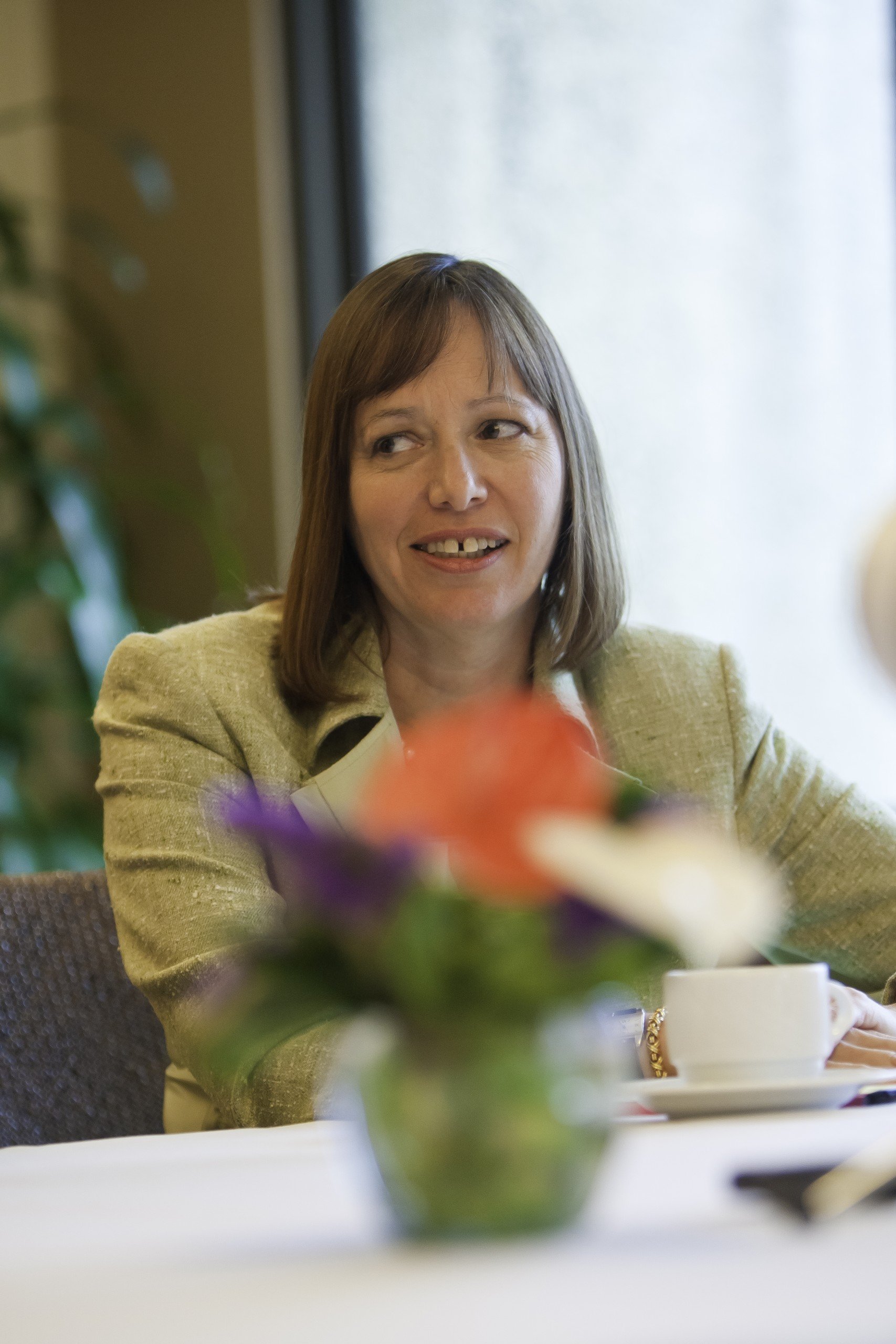Power Players

Participants in this discussion:
Margery Bronster
Partner, Bronster Hoshibata and
former state attorney general
Shari Chang
Senior VP, marketing and revenue management,
Aston Hotels and Resorts
Kathryn Inouye
COO, Kobayashi Group
Constance Lau
President and CEO,
Hawaiian Electric Industries
Janet Liang
President, Hawaii Region,
Kaiser Permanente
Dee Jay Mailer
CEO, Kamehameha Schools
Gwen Pacarro
Complex Manager for Hawaii,
Morgan Stanley Smith Barney
Shara Enay
Moderator, writer,
Hawaii Business Magazine
The first question is why we’re here: How do we get more women in Hawaii to the C-suite – that is the CEO, CFO, COO positions for nonprofits, businesses and corporations – and what steps should women take to get there?
Inouye: In the not-for-profit sector it is probably a little bit easier. The challenges are in for-profit businesses. Today, the workforce is about 50-50 men and women, but there is a much smaller percentage of women in the C-suite. There’s a lot that needs to be done. I think it starts with education – more encouragement to women and to girls to pursue more ambitious fields and if educators are not familiar with people in those fields, they have to bring in mentors.
Mailer: The best way for women to get to the C-level is to step up to every opportunity and not worry whether they have all the credentials, experience or knowledge. Bank on your generic traits such as being collaborative, intuitive, a galvanizer, a synthesizer. If you’re courageous enough to step forward when an opportunity exists or create that opportunity, then suddenly you’re visible and influential.
Lau: A lot of women don’t want to accept promotions. That may fit at a certain point in your life, but, later on, when you have more time and your kids are grown, then you’ve got to step up. Women have to be willing to take risks. If you’re not willing to take risks, you aren’t going to get that promotion.
Liang: Take on extra assignments to become visible, but seek jobs and projects where there is operational accountability or accountability for the bottom line. Often, women take planning roles, chief-of-staff roles, process, organizing, and those aren’t career-track positions.
Chang: In my industry, women don’t have the equivalent of an old-boy network. So it’s important for us to provide that support system. Also, men have time for social networking, whereas many women go out of work and into their second career, the family. So, we need to find ways for them to build connectivity.

Photo: David Croxford
“In my industry, women don’t have the equivalent of an old-boy network. So it’s important for us to provide that support system.” – Shari Chang
Liang: I ask women: Are you married yet? Who is your partner? If you want to be a chief executive, let me tell you about the kind of guy you need in your life (laughter by others), so you can have it all. You will need time off work to have a child or because the child is sick, and at work, that diminishes your ability to be successful. You have to manage your own affairs at home so it doesn’t become an issue for your employer.
Inouye: Traditionally, if husband and wife were both working, the woman did most of the household chores and childrearing. Now, there is more balance because men want to be involved in childrearing and because women demand their husbands take on some chores (laughter). That gives women more time to do late hours or business dinners. Those are requirements if you want to move up. Companies can help with family-friendly policies so both men and women can take off when the children are sick or to go to the May Day program. It creates happy, loyal employees and higher productivity.
Enay: Should women find a good mentor? If so, how should they select that person?
Inouye: This magazine (laughter).
Chang: It starts in your own company but must also be outside your company. I’ve been following the career of a lady who worked with us years ago and she just called to ask, “Could we have lunch, because I have a big career move and I want to get your opinion.” We have to keep those relationships and be available even if we’re busy. That means so much to them if you can give advice.
Bronster: You’re not limited to women mentors. (General agreement.) Many of us started our careers when there were very few women leaders. I was at a firm of 500 lawyers in New York and there were only two female partners out of a hundred. There were dozens of young female attorneys and the partners didn’t have the time. So you needed to reach out to someone who appreciated what you had to offer and, in my case, a number were men.
Mailer: However, if you’re constantly looking for a mentor, that can play against you. Rather, step up, show what you can do, and people will notice you and want to mentor you. You don’t have to ask. They’ll give you advice because they see potential.
Lau: The point Dee Jay makes is especially relevant if you’re going to be CEO, because in the CEO suite, the buck stops with you. (General agreement.) So, you really aren’t looking for advice. You’ve got to make those decisions.
Enay: A lot of you are on community and corporate boards. Is that a good steppingstone for women who want to develop their careers?
Lau: Being on boards is really great particularly because you get a broad view of an organization and you get to talk about its strategy, how the world around it is changing, how would you position that organization. Those are all very useful skills in your own job. For really good boards, sometimes you have to be asked, so you want to be able to sit on boards as soon as you can, but you also have to develop your reputation so you’ll be asked to join the right boards.
Pacarro: Boards are a great way to pick up skills that you’re not getting elsewhere. When I was in my 20s, I joined organizations that were primarily women-related simply to have that safety net and then to develop onto other boards. But it allowed me a chance to try out the different positions – whether it be secretary, treasurer, vice president, or president – to see what that felt like and to take the risk to learn.
Lau: It’s also a great networking opportunity because the people on boards are usually very diverse, so you have an opportunity to learn what other people do in their jobs and how they might approach problems.

Photo: David Croxford
“Collaboration, cooperation, bringing the community together – I think those are important traits that women tend to have. Seeing the best in others, trying to bring out the skill sets of those around you, finding out who to develop.” – Gwen Pacarro
Liang: And you can experiment. If you want to hone your finance skills, sit on the finance committee. That’s a way you can do it that is not as threatening as in your job, so it’s a great place to learn and to experiment.
Enay: Does the glass ceiling still exist?
Lau: I don’t think there is any question that it still exists. (General agreement.) And, particularly, at about age 35, because that’s when women want to have families and, oftentimes, they take themselves voluntarily off of progression, or it happens because you can’t spend the time that you need to do a great job and advance.
Mailer: It’s true that the glass ceiling is still there, but I choose not to care about it, because if you do, it’s there. We’re all sitting in places where we can expose other women to opportunities and one of the best ways is when an organization has a big challenge. Assign a young woman or four or five of them to work out the challenge. Then they become known as the go-to people.
Bronster: Each of us has been very lucky. Each of us has had opportunities, but I think that to deny that the glass ceiling exists is a disservice to young women. About 50 percent of the young lawyers admitted today are female, but there are very few female main partners at law firms. Same in accounting. So, we have to recognize that the glass ceiling still exists, but it’s not impossible to break through.
Liang: In hospital healthcare in Hawaii, roughly 75 percent of the employees are women, and in the No. 2 spot more than 50 percent are women, but at the top level, about 20 percent of the hospital CEOs in Hawaii are women. Nationally, its 10 percent. Getting to the next level is not necessarily about the leadership hard skills, but some of the soft skills: presence; being able to build community relationships; in healthcare, it’s working with medical groups, which tend to have male leaders, and the specialists tend to be male.

Photo: David Croxford
“I ask women: Are you married yet? Who is your partner? If you want to be a chief executive, let me tell you about the kind of guy you need in your life (others laugh), so that you can have it all.” – Janet Liang
Chang: In the tourism workforce, women dominate, but in the upper-level positions, other than the family-owned companies, you don’t see women at the very top very often.
Pacarro: I like to view the glass ceiling as, “OK how do we get through it? How do we get through and around it, rather than feel it is impenetrable?”
Enay: Do you think women have to work harder than men to get to the top?
Inouye: Way back in another company, I was told by my immediate supervisor, that to get ahead, “You’ll have to work twice as hard as anybody in this office.” I looked around and thought, “That’s not going to be too hard.” (Laughter.) But I would say that for anyone, male or female, to get ahead you have to work hard to be recognized.
Liang: For some reason, there is more criticism of women, so women often get feedback about behaviors, how you use your power, or how you show up emotionally at work, whereas for men there is more of a free pass. That’s just part of reality, but I’m not pessimistic about that. Partly, you have to have the capacity to take it in stride, with some humility and laughter. How many times has somebody thought I was the secretary and handed me things to copy? (Laughter.)
Enay: What characteristics gave you an edge?
Chang: Confidence certainly helps, but also learning how to face some battles and not back down too fast. You sometimes have to compromise, but if you back down too fast, you’re just going to be run over. One of women’s biggest challenges in our industry is skills that are admired in men – perseverance, directness, being a hard-charger – are construed in women as being combative, not a team player. (Others agree). We face that constantly and have to get people beyond those feelings.
Pacarro: Collaboration, cooperation, bringing the community together – I think those are important traits that women tend to have. Seeing the best in others, trying to bring out the skill sets of those around you, finding out who to develop. We tend to look for that more because we do that in our children. I’m not saying men don’t do that, but we tend to have more of a knack for it.
Mailer: Find ways that you can do vs. you can’t. Whenever people are talking about why something is so hard that it can’t happen, be the one who figures out a solution. That will set you up to be a leader in the next round.

Photo: David Croxford
“Whenever people are talking about why something is so hard that it can’t happen, be the one who figures out a solution. That will set you up to be a leader in the next round.” – Dee Jay Mailer
Liang: Women have a hard time promoting themselves, but you have to. If you do good work, people need to know. If someone describes you as a workhorse, team player, great person, those compliments typically come before, “Not a leader. Workhorse but not a leader.” You don’t want to get trapped in the mentality of “If I just work really hard, somebody will recognize me.” Women have to take control of their recognition, especially in large corporations.
Bronster: What are the traits leaders have? Integrity, dedication, humility, openness, creativity, fairness, assertiveness – not to be confused with aggressiveness – and a sense of humor. None of those strike me as particularly male-based. Women who have all of those leadership traits can make it.
Inouye: One thing that is critical in any leader is being an effective communicator, whether you’re dealing with bureaucrats or antidevelopment groups or children or engineers or financiers. You can’t take your stock speech with all audiences. Also, listen well and respond creatively to people’s concerns. Some people say, “I’m not good at speaking in public.” No one’s born being able to speak up – it’s a skill that’s learned over time and with practice.
Enay: What is the difference between being assertive and being aggressive?
Inouye: It’s how the message is delivered. In Hawaii – male or female – you can’t come across like a bulldozer. It is usually someone from the Mainland who comes across as, “I’m going to tell you guys how it’s done.” You have to feel your audience out and come across with a sense of humor.
Pacarro: I think the assertive person takes into consideration what is around them and asserting their message, whereas the aggressive person has got their ears closed.
Bronster: A leader must have the ability to make a decision. Sometimes it’s a hard decision or not completely agreed to by everybody, and that’s where I see a lot of young women faltering, and men, too. Women who want to be collaborative and want a buy-in from everybody – that can lead to a decision that is not going to be good for anybody.

Photo: David Croxford
“A leader must have the ability to make a decision. Sometimes it’s a hard decision or not completely agreed to by everybody, and that’s where I see a lot of young women faltering, and men, too. Women who want to be collaborative and want a buy-in from everybody – that can lead to a decision that is not going to be good for anybody.” — Margery Bronster
Inouye: It’s important to be persistent in the face of challenges and criticism, because you know what needs to be done and how.
Enay: Does anybody have lessons that other women could learn from?
Mailer: Two are important to me. One is not getting the job. Your career’s going gangbusters and so you apply for a CEO position. You feel really good about your interview and they say, “Sorry, we’ve picked someone else.” It’s a defining moment. Do you relegate yourself to other things or just look for the next opportunity? Lesson two: be clear about the organization you want to work for. If you don’t resonate with the values and mission of that organization, you will find yourself fighting against a storm and you won’t be at your best.
Inouye: Don’t stay in a dead-end job too long. Don’t be without a job, but don’t stay too long either just because it’s giving you a paycheck.
Enay: What’s the biggest risk you’ve ever taken?
Lau: Probably going into a job that I knew nothing about. To develop their young talent, corporations like ours often move people to jobs they have no background in, but we believe in their leadership and management skills, and we believe they can learn a new area. That can be very scary, but that’s your opportunity to prove yourself, so you have to be willing to do those things. I think women tend to want to do that less than guys.

Photo: David Croxford
I don’t think there is any question that [the glass ceiling] still exists. And, particularly, at about age 35, because that’s when women want to have families and, oftentimes, they take themselves voluntarily off of progression.” — Constance Lau
Bronster: You need to step outside your comfort zone. When you said you took a job that you didn’t know anything about; I did that once, too. (Laughter.) When Governor Cayetano asked me to be attorney general, I was literally reading the Constitution to see what that job entails. I definitely stepped outside of my comfort zone, but it was a great opportunity.
Lau: People wouldn’t have asked you if they didn’t have confidence that you could get the job done.
Liang: I was in a company for 15 years. I was in the No. 2 spot, but I was ready to be a president and I have my own vision on how I want to do things. So I moved to Hawaii with my family, and it was fairly risky, and there’s nobody here that I knew. It was the top job in a market that was challenging and at the same time I was new to the company. You have to take those risks if you want that top job.

Photo: David Croxford
One thing that is critical in any leader is being an effective communicator, whether you’re dealing with bureaucrats or antidevelopment groups or children or engineers or financiers. You can’t take your stock speech with all audiences. Also, listen well and respond creatively to people’s concerns. Some people say, “I’m not good at speaking in public.” No one’s born being able to speak up – it’s a skill that’s learned over time and with practice.” — Kathryn Inouye
Pacarro: A lot of young people think there’s a class that provides you with a curriculum for every job. But you don’t get a manual. (Laughter.) Those that hired you recognize that your life is your entire experience toward that job. You have to learn it on the job. OJT is what the world is about.
Lau: And even if you are in a job, the world is changing constantly and great leaders have to be able to adapt.






